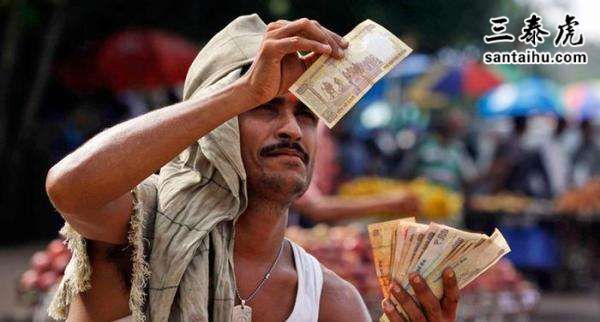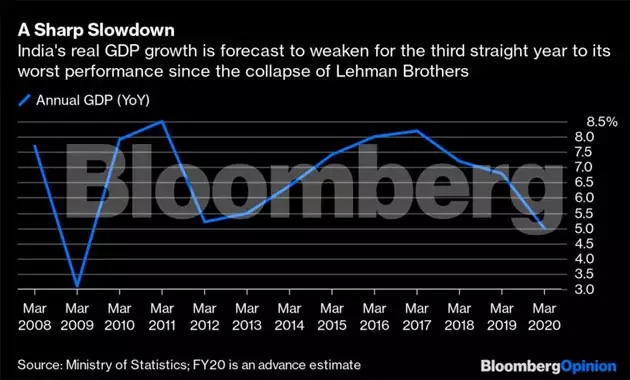How to get India out of this frustrating and complex recession
如何让印度走出这场令人沮丧和错综复杂的衰退
India has more than a sixth of the world's population. It’s also still a poor country. So what happens there is incredibly important for the welfare of the human race.
印度人口占世界总人口的六分之一以上。印度现在还是一个贫穷的国家。所以印度的局势对全人类的福祉非常重要。
For a long time, good things were happening in India. Cautious pro-business reforms in 1980s were followed by the dismantling of much of the country’s overbearing regulatory state in the 1990s and 2000s. At the end of a long boom, India was five times richer per capita than in 1980.
很长一段时间,印度一直都很走运。在上世纪80年代谨慎进行亲商改革之后,上世纪90年代和本世纪头十年,印度废除了大部分的监管机构。在长期繁荣结束时,印度的人均财富达到了1980年的5倍。

Although the gains tended to go to a small slice of the population, India managed to make great strides against extreme poverty; it’s no longer the country with the largest number of very poor people (that dubious distinction now goes to Nigeria). Development has meant food, shelter and sanitation for hundreds of millions of Indians.
尽管资金往往只会流向一小部分人口,但印度在消除极端贫困方面取得了巨大进展;它不再是拥有最多赤贫人口的国家(这一可悲的荣耀现在属于尼日利亚)。这样的发展意味着为数亿印度人提供了食物、住所和卫生设施。
But this good news is now old news. The country has entered a major economic slowdown.
但是这个好消息现在已经成旧闻了。印度已进入严重的经济衰退。

A Sharp Slowdown
大幅放缓
The growth number probably understates the magnitude of the slump. Industrial production has actually shrunk in recent months, as has the production of capital goods. Electricity generation has also slowed by more than gross domestic product growth.
经济增长的数字可能低估了衰退的程度。近几个月来,工业生产实际上已经萎缩,资本货物的生产也是如此。发电量增速放缓的幅度也超过了国内生产总值增速。
A series of interest-rate cuts has failed to stop the decline. India already has real interest rates of negative 2.2%, lower than other develo Asian countries, suggesting that monetary policy isn't going to be the answer. The government of Prime Minister Narendra Modi has also been engaging in structural reforms since last summer — cutting taxes, opening up the country to more investment and privatising industries. But although these might help in the long run, they have failed to stem the recessionary tide.
一系列的利率下调并没有阻止经济下滑。印度的实际利率已经达到了负2.2%,低于其他亚洲发展家,这表明货币政策不会是解决问题的办法。自去年夏天以来,印度总理纳伦德拉•莫迪的政府也一直在进行结构性改革,包括减税、接纳更多投资以及行业私有化。然而,尽管这些措施从长远来看可能有所帮助,但它们未能阻止衰退的浪潮。
Diagnosing the cause of the crisis has been difficult. In a new paper, economists Arvind Subramanian and Josh Felman argue that the root of the problem isn't a shortage of aggregate demand, or even Modi policy blunders such as demonetisation, taking currency out of circulation. Instead, imbalances in the country’s growth model have led to a buildup of bad assets in the financial system.
诊断危机的原因很困难。在一篇新论文中,经济学家阿文德•萨勃拉曼尼亚和乔希•费尔曼认为,问题的根源不在于总需求不足,甚至也不在于莫迪的政策失误,如废钞令、让货币退出流通。相反,是由于印度增长模式的失衡导致了金融体系中的不良资产不断累积。
Before the global financial crisis of 2008, Subramanian and Felman note, India’s exports were growing robustly. But then in about 2011-12, when export growth slowed as a result of the crisis, investment fell, corporate profits were squeezed and business loans began to go bad. A rise in troubled loans on bank balance sheets should have caused a recession, but India’s economy was saved by a combination of falling oil prices, a boom in shadow banking and government stimulus. These, the economists argue, gave the economy a lift by causing consumption to rise while also creating a housing bubble. Banks became ever-more exposed to real estate.
萨勃拉曼尼亚和费尔曼指出,在2008年全球金融危机之前,印度的出口强劲增长。但在2011年至2012年左右,由于危机导致出口增长放缓,投资下降,企业利润受到挤压,商业贷款开始转变为坏账。银行资产负债表上不良贷款的增加本应导致经济衰退,但油价下跌、影子银行繁荣和政府刺激措施共同拯救了印度经济。经济学家们认为,这些措施在刺激消费的同时,也催生了房地产泡沫,提振了经济。银行对房地产的风险敞口越来越大。
Now, Subramanian and Felman claim, India’s housing bubble has burst, with prices starting to fall as unsold inventory piles up. That is adding to the stock of bad loans on bank balance sheets — which had never really recovered from the souring of corporate loans a decade earlier — while also putting stress on the shadow banking system. This, they say, was the cause of the abrupt drop in lending in 2019.
现在,萨勃拉曼尼亚和费尔曼声称,印度的房地产泡沫已经破裂,随着未售出库存的堆积,房价开始下跌。这增加了银行资产负债表上的不良贷款存量,同时也给影子银行体系带来了压力。他们说,这就是2019年贷款突然下降的原因。
So to get India’s economy going again, bank balance sheets need to be cleaned up. Modi has been merging government-owned banks, but there is much more that can be done. Similar to what the Federal Reserve did in the US after 2008, the Reserve Bank of India should engage in quantitative easing to purchase loans from banks and shadow banks. This might give rise to inflation, which is accelerating — something that was absent in the US after 2008. But it could help get loans flowing through the economy again. Modi’s government can also help by creating a so-called bad bank to absorb troubled loans.
因此,为了让印度经济重新启动,需要对银行的资产负债表进行清理。莫迪一直在合并国有银行,但还有很多事情可以做。与美联储在2008年后对美国的做法类似,印度央行应该实施量化宽松,从银行和影子银行购买贷款。这可能会导致通胀加剧——美国在2008年之后没有出现通胀。但它可能有助于让贷款再次在经济中流通。莫迪政府也可以通过建立所谓的坏账银行来吸收不良贷款。
But at the same time, India shouldn’t ignore the need for long-term structural reforms. Cleaning up bank balance sheets might stem the current slump, but until lenders see a major set of new opportunities, the economy won’t return to rapid growth.
但与此同时,印度不应忽视长期结构性改革的必要性。清理银行资产负债表可能会遏制当前的衰退,但在银行看到一系列重大的新机遇之前,经济不会恢复快速增长。
Urbanisation Still Awaits
城市化仍有待进行
Urbanisation is a driver of growth. Moving people from farms to cities would help alleviate India’s low agricultural productivity, because the same land would be farmed by fewer workers. If the new urban residents get jobs in labour-intensive manufacturing, incomes would rise very quickly, so India should couple urbanisation with a drive to absorb some of the manufacturing jobs. But even if city dwellers work in the service sector, it’s better than being on the farms.
城镇化是经济增长的动力。将人们从农场转移到城市将有助于缓解印度较低的农业生产率,因为同样的土地将由更少的工人耕种。如果新的城市居民在劳动密集型制造业找到工作,收入将迅速增长,因此,印度应该在城市化的同时,努力吸收一些制造业工作。但即便城市居民在服务业工作,也比在农场工作要来得更好。
India can help medium-sized cities grow by building better urban infrastructure and providing better urban services. It could even offer financial incentives to encourage people to move. The subsequent revival in the housing market, and a cheap labour force for low-end manufacturing, would give recapitalised banks more opportunities to lend. That could give India a manufacturing growth model similar to that of Bangladesh or Vietnam.
印度可以通过建设更好的城市基础设施、提供更好的城市服务来帮助中等城市发展。它甚至还可以通过经济激励手段来鼓励人们迁徙。房地产市场的复苏,以及低端制造业的廉价劳动力,将为资本重组后的银行提供更多的放贷机会。这可能会给印度带来类似于孟加拉国或越南的制造业增长模式。
Thus, a combination of macro and micro policies might be just what’s needed to get India out of its frustrating and complex recession.
因此,宏观和微观政策的结合可能正是印度走出令人沮丧、错综复杂的衰退所需要的良方。
以下是《印度经济时报》网站读者评论:
译文来源:三泰虎 http://www.santaihu.com/49405.html 译者:Joyceliu
Kumar Bangalore
Stop increasing IT. Give benefits to users who are in the lower rung of IT slabs. Bring rich businessman and rich farmers into income tax paying category. Increase spending on Railways which gives cost effective transportation and start building more number of railway lines.
别再继续发展IT业了。为处于IT低端的用户提供一些好处吧。将富商和富农纳入所得税纳税范畴。增加对铁路的投资,使其具有成本效益,并建设更多的铁路线。
Mickky
stop comparing apple and orange, author should focus on some other issue,India dose not have any monopolies global leading industry like apple google, we have only service based industry and rest is only limited to few more nation which is not suffice to generate money, thank god that we have population otherwise nobody wants India (Harsh but true).
别再瞎比较了,作者应该将视线聚焦在其他问题上,印度没有像苹果谷歌那样垄断全球主导产业,我们只有服务行业,其他行业只是局限于几个国家,感谢上帝,我们有人口,否则没人想要印度(话虽糙但理没错)。
Vinod
Why sell you land and move to the cities? When every year you can take loans with no need to pay and also get doles from central and state governments! The middle class in cities exsts to serve these parasites
为什么要卖地搬到城市去呢?每年都可以申请贷款,又不用还钱,还可以从中央政府和州政府得到救济!城市里的中产阶级就是为这些寄生虫服务的。
Anand V
Ban Import from ......even 2.5 lac crore (half of present 5 lac per annum import from ) worth of products domestic manufacturing will generate millions of jobs that India urgently needs
禁止从进口,即使只是2.5万亿卢比(目前每年从进口额5万亿卢比的一半)的产品,也能让国内制造业创造数百万印度急需的就业机会。
Raaj
over regulation, excessive legislation,mindless and malicious implementation conferring authority on petty officials disproportionate to their merit and capability and choked risk appetite .. over weight bureaucracy working to smooth line policies (read Complicating ) is cause. entreneurship profiles are not known to policy makers result people going for haircut to cobblers, Plumbers doing heart bye pass surgeries
过度的监管、过度的立法、盲目而恶意的执法、将权力授予与他们的品德和能力不相称的小官员、抑制风险偏好……过度繁重的官僚主义就是罪魁祸首。政策制定者不了解企业家的情况,结果是人们找修鞋匠剪头发,水管工实施心脏手术。
True Indian
India has become A FOOLS PARADISE UNDER MODI RULE. Nobody knows how to cure the ailing Indian Economy
在莫迪统治下,印度已经变成了愚人的天堂。没有人知道如何解决印度经济的困境。
Yash Pal
Those who who give sound advice are called fools by the present dispensation's followers.
那些提出正确建议的人,被当前分配制度的拥护者称为傻瓜。
Ken Nihon
boring write up ! As the few measures written here, are already being taken up by the Government. Bloomberg fellows just have no clue what they are talking about, this guy is similar to Andy Mukh annd Mihir Sharmilie. Senseless write up
无聊的文章!这里提到的一些措施,已经被政府采用了。彭博社的人根本不知道他们在说什么,这个家伙和安迪·穆克和米希尔·莎米利很像。毫无意义的文章。
Kanakasabhai Natarajan
There is nothing new in the article and old wounded horses that left like Arvind Subramaniam are advising now. The world among large countries except the US and and in recession and is struggling with virus. The US is just growing and 5% in India is nothing to laugh about. FDI is good and world manufacturing will realign. India will reach 6% plus soon but 8% will be tough. After 2 decades of big growth some slow down is natural. Bloomberg for quite sometime has been writing negatively about India. It’s called mad media in the US cut off from reality.
这篇文章毫无新意,阿文·苏布拉曼尼亚姆这样留下的受伤的老马现在也在提建议。世界上除了美国和以外的大国都陷入了衰退,正与病毒搏斗。美国只是在增长,而印度的5%也没什么好嘲笑的。外国直接投资是好事,世界制造业将重新洗牌。印度将很快达到6%以上,但8%真的很难。在经历了20年的高速增长之后,自然会出现一些放缓。很长一段时间以来,彭博社一直在负面抹黑印度。这在美国被称为与现实隔绝的疯狂媒体。
Chandra
Chuthiya 5% growth of a per capita GDP which is lower than Vietnam is peanuts. First you morons need to understand which is faster growth 2% of 20 trillion or 5% of 3 trillion
人均GDP 5%的增长比越南还低,这没啥。首先,你们这些笨蛋需要知道,哪一个增长更快,是20万亿的2%还是3万亿的5%。
Kanakasabhai Natarajan
You MCP degrading women with a drunkards language in slums. India is not Vietnam nor is it the US. It is the 2nd fastest growing economy after . For your peanut size brain Google for an economy growing in double digits may be in Atalantic or Pacific Ocean the size of a few million dollars and then ask why India doesn't grow at that level. Your level is so bad that you go for medical treatment.
你们在贫民窟里用酒鬼的语言侮辱妇女。印度不是越南,也不是美国。它是继之后增长第二快的经济体。对于你那芝麻绿豆大小的脑子,谷歌搜索一下大西洋或太平洋地区经济增长速度达到两位数,规模几百万美元的经济体,然后问印度为什么没有增长到那个水平。你的水平太差了,得去看医生了。
Nachiket Katha
Only hope for India are secular and peaceful students from premier universities/institutes of India who would force this government from CAA/NPR/NRC chronology and bring them on track where economy gets focus it deserves. Trump may be idiot but who would do nothing that would disrupt US economy.
印度唯一的希望是来自印度一流大学/研究院的世俗和平学生,他们将迫使政府走上正轨,专注于经济。特朗普可能是个白痴,但他不会做任何会破坏美国经济的事情。
Ken Nihon
silly leftist BS !
愚蠢的左派!
Yash Pal
Truth hurts.
真相太伤人了。
Taher Ali
The author doesn't even know what a recession is lol
作者连什么是经济衰退都不知道,哈哈
Mukul Roy/Power
15% can put forward their claims & grievances but cannot blackmail a de ocratically full majority govt. to withdraw CAA by adopting tactics of ROAD BLOCK & Violence.
15%的人可以提出他们的诉求和不满,但不能通过采取路障和暴力的策略来勒索印度撤回CAA。
Mukul Roy/Power
Only one Solution - Hitting hard by Police with Bamboo dipped in Mustard oil for hours. Road block is not acceptable. This is a proven practice by many nations . Adopt this practice for instant results.
唯一的解决办法就是让警察用蘸了芥末油的竹棍猛击几个小时。设置路障是不可接受的。这是被很多国家证明有效的做法。采用这种方法可以立竿见影。
Clinical Microbiology
Its just because of Jio, more youth are not working and ALL most 60 percent are playing in mobile apps.govt has no good policies to help small scale industries and support them.
因为Jio,更多的年轻人没有工作,60%的人都在玩移动应用。政府没有好的政策来帮助和支持小型产业。
Yash Pal
Non clinical diagnosis.
非临床诊断。
Anand V
Ban products .......5 lac crores of junk annually imported had killed most industries in india
抵制货……每年进口的5万亿卢比的商品扼杀了印度的大部分工业。
外文链接:https://economictimes.indiatimes.com/news/economy/policy/how-to-get-india-out-of-this-frustrating-and-complex-recession/articleshow/74294487.cms
 诺贝尔经济学奖得主:印度可能正在经
诺贝尔经济学奖得主:印度可能正在经 IMF总裁:印度经济增长放缓是暂时的
IMF总裁:印度经济增长放缓是暂时的 莫迪总理称,印度经济基本面强劲,能够
莫迪总理称,印度经济基本面强劲,能够 观点:印度经济如何回归现实
观点:印度经济如何回归现实 印度工业联合会:印度经济或在2020年
印度工业联合会:印度经济或在2020年 IMF:印度经济显著放缓,需采取紧急政
IMF:印度经济显著放缓,需采取紧急政 伍德:印度经济增长急剧下滑,政府应该
伍德:印度经济增长急剧下滑,政府应该